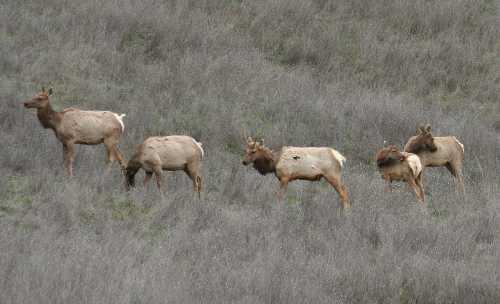
NORTHERN CALIFORNIA – Healthy herds of tule elk (Cervus canadensis ssp. nannodes) make their home in the Berryessa Snow Mountain region.
This subspecies of elk found only in California had been hunted and poached so extensively that by 1870 they were actually thought to be extinct.
Thanks to conservation efforts, including those by California cattle baron Henry Miller in 1873 – who spared and protected a mating pair on his ranch – and the California Department of Fish and Wildlife, which in 1969 protected a herd of 80 head in the Cache Creek area and in 1978 protected another herd in Lake County, the state population of these handsome and unique elk has grown to more than 4,000. Their range now extends from the Central Valley to the coast.
The tule elk are sometimes inaccurately referred to as “dwarf elk” because they are generally smaller in size than other species, like the Rocky Mountain Elk.
The smaller size of most tule elk is attributed in part to genetics and in part to their diet which consists of a variety of grasses, leaves, reeds and forbs (such as sunflowers and milkweed), and aquatic vegetation when available.
Although most tule elk bulls weigh between 450 and 500 pounds, and the cows weigh around 350 to 425 pounds, the California Department of Fish and Wildlife records for the elk in the Grizzly Island Wildlife Area at Suisun City weighing in at about 900 pounds.
Still, even a 500-pound male is a pretty awesome sight. Standing at up to 5 feet high at the shoulder, adult males can be about 7 feet long and sport a rack of heavy six-point antlers which by themselves can weigh upwards of 40 pounds.
The antlers, often confused with horns (which are slow-growing permanent structures), are made of solid bone and are shed and regrown every year. In the spring, new antlers are covered with a webwork of blood vessels and tissue known as “velvet” that feeds the bone as it grows (at a rate of about 1 inch per day).
The velvet is gone by the summer, and in the winter the antlers themselves are shed.
A common myth is that the points on the elk’s headgear reflect its age. That’s not accurate. Twelve years is an average lifespan for these elk (although some can live as long as a quarter century), but they will still only generate about six points on their rack.
If you see a “spike bull,” a young elk with unbranched antlers, you know he’s less than 2 years old.
During the breeding season in the fall, mature bull elk “in rut” will use their antlers in part to intimidate younger males, but also as weapons against well-matched bulls to establish dominance when less violent alternatives like vocalization, called “bugling,” and posturing fail.
As his prize for winning, the dominant male does 80 percent of the breeding in the herd.
Mated females will have their calves, weighing in at around 20 pounds at birth, a little more than eight months later, usually in May and June. The youngsters are weaned within a few months, just as their spotted coat is replaced by the traditional “tule-elk-tan” coat, and immediately join the herd.
Viewing these creatures can be a lot of fun, but for your own safety and the safety of the elk, follow these basic guidelines:
- View the elk at a distance. Using the telephoto setting on your camera, a scope or binoculars are ideal.
- Never get between a cow and her calf.
- Never put yourself between a dominant bull and his harem, or any bull and its rival.
- Whisper, watch quietly and keep your movements slow.
Oh, and if you come across some antlers that have been shed, leave them where they are. Rodents and deer use them as a source of calcium.
If you want a souvenir of your find, take a photo of the antlers to share with your friends and family.
Tuleyome Tales is a monthly publication of Tuleyome, a conservation organization with offices in Woodland and Napa, Calif. For more information and an online species guide for the Berryessa Snow Mountain region, go to www.tuleyome.org . Mary K. Hanson is an amateur naturalist and photographer, and executive assistant/membership coordinator for Tuleyome.


 How to resolve AdBlock issue?
How to resolve AdBlock issue? 



